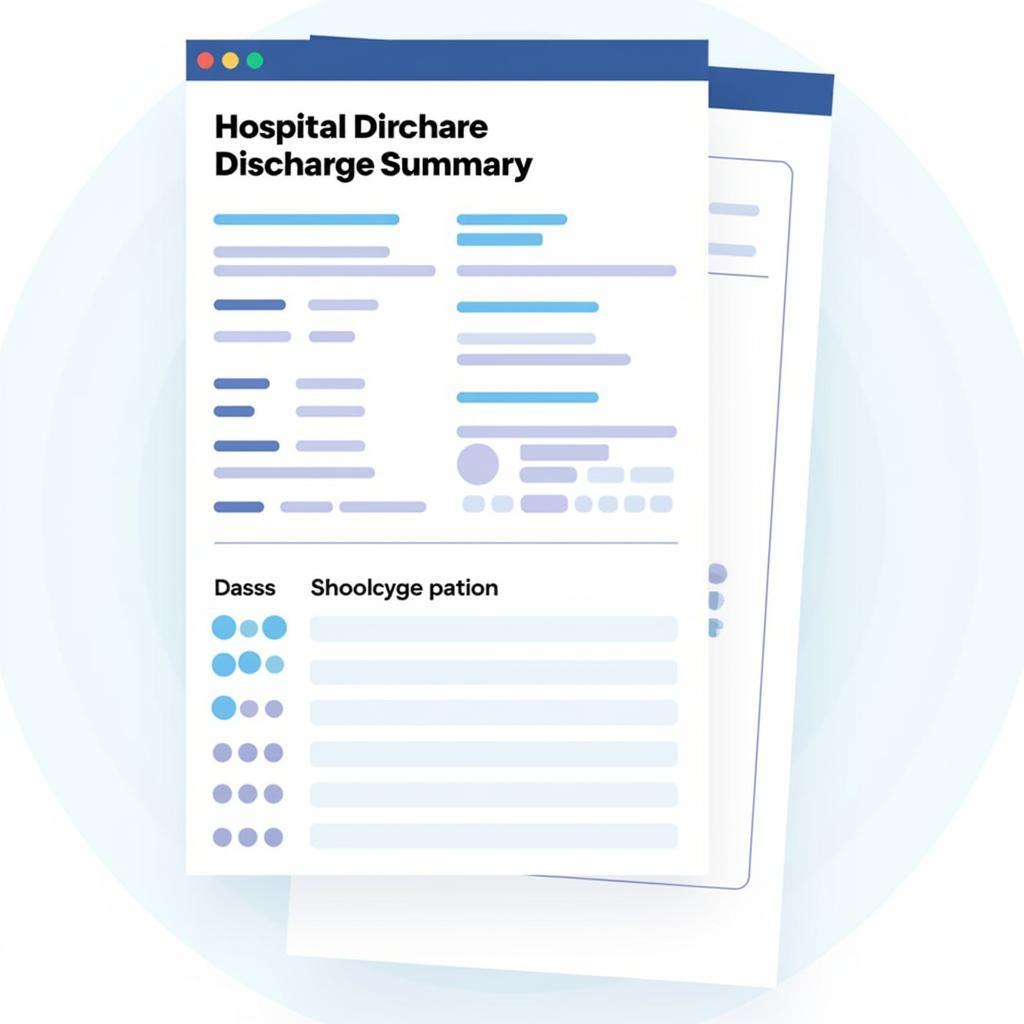A Hospital Discharge Summary Template is a crucial document that bridges the gap between inpatient care and outpatient follow-up. It provides a concise yet comprehensive overview of a patient’s hospital stay, ensuring continuity of care and facilitating effective communication between healthcare providers. This detailed guide will delve into the importance of a well-structured discharge summary, exploring its key components and offering practical tips for creating an effective template.
Why is a Hospital Discharge Summary Template Important?
A standardized hospital discharge summary template ensures consistency and completeness in documenting patient information. It streamlines the discharge process, reducing the risk of errors and omissions that could compromise patient safety. Furthermore, it serves as a valuable reference for future medical encounters, enabling healthcare providers to quickly access pertinent information about a patient’s medical history. A well-crafted template also facilitates accurate billing and coding, optimizing reimbursement processes.
A good discharge summary template also benefits patients. It empowers them to actively participate in their ongoing care by providing a clear understanding of their diagnosis, treatment plan, and follow-up instructions. This clarity reduces anxiety and promotes adherence to prescribed medications and appointments.
Key Components of a Hospital Discharge Summary Template
A comprehensive discharge summary template should encompass several key elements:
- Patient Demographics: Accurate patient identification is paramount. This includes the patient’s full name, date of birth, medical record number, and contact information.
- Reason for Admission: A concise description of the primary reason for the patient’s hospitalization.
- Medical History: A summary of the patient’s relevant medical history, including pre-existing conditions, allergies, and previous surgeries.
- Diagnosis: A clear and concise statement of the diagnoses made during the hospital stay.
- Treatment Summary: A detailed account of the treatments administered, including medications, procedures, and therapies.
- Medication Reconciliation: A comprehensive list of the patient’s current medications, including dosage, frequency, and route of administration.
- Follow-up Instructions: Clear instructions for follow-up care, including appointments with specialists, recommended tests, and lifestyle modifications.
- Discharge Disposition: Information about where the patient is being discharged to (e.g., home, rehabilitation facility).
Creating an Effective Hospital Discharge Summary Template
Developing an effective hospital discharge summary template requires careful planning and consideration of the needs of both healthcare providers and patients. It should be user-friendly, easy to navigate, and readily accessible to all authorized personnel. The template should be regularly reviewed and updated to reflect current best practices and regulatory requirements.
fake hospital discharge form template free word can be a starting point, but ensure it adheres to all legal and ethical guidelines. It’s also crucial to prioritize clear and concise language, avoiding medical jargon that patients might find confusing.
What Information Should Be Included?
Every effective hospital discharge summary should answer the five Ws and one H: Who, What, When, Where, Why, and How. This approach ensures comprehensive documentation and facilitates effective communication.
How Can I Simplify the Discharge Process?
Using a standardized template, leveraging electronic health records, and implementing a clear discharge process can streamline the procedure, minimizing delays and improving patient satisfaction.  Streamlined Discharge Process using a Template
Streamlined Discharge Process using a Template
“A well-designed discharge summary is not just a document; it’s a roadmap for the patient’s continued well-being,” says Dr. Emily Carter, a leading expert in patient care transitions.
Optimizing Your Hospital Discharge Summary Template for Clarity
Clarity is paramount in a discharge summary. Use simple language, avoid abbreviations, and organize information logically. This ensures that both patients and healthcare providers can easily understand and act upon the information provided.
“Empowering patients with clear and concise information is essential for their successful transition from hospital to home,” adds Dr. Michael Rodriguez, a specialist in patient education.
Conclusion
A comprehensive and well-structured hospital discharge summary template is a cornerstone of effective patient care. It ensures continuity of care, facilitates communication, and empowers patients to actively participate in their own health management. By following the guidelines outlined in this article and prioritizing clarity and completeness, healthcare providers can create discharge summaries that truly benefit patients and contribute to improved health outcomes. Remember, the hospital discharge summary template is an invaluable tool for ensuring safe and effective patient transitions. note mercy hospital letterhead
FAQ
- What is the purpose of a hospital discharge summary?
- Who should receive a copy of the discharge summary?
- What information is typically included in a discharge summary?
- How can I ensure the accuracy of a discharge summary?
- What are the legal requirements for hospital discharge summaries?
- How can technology improve the discharge summary process?
- What are the benefits of a standardized discharge summary template?
Situations regarding discharge summary templates:
-
Scenario 1: A patient is being discharged after a complex surgery and needs detailed instructions for post-operative care. A well-structured discharge summary template ensures that all necessary information, including medication schedules, wound care instructions, and follow-up appointments, is clearly documented.
-
Scenario 2: A patient is transferred to a rehabilitation facility after a stroke. The discharge summary template facilitates seamless communication between the hospital and the rehabilitation facility, ensuring continuity of care.
-
Scenario 3: A patient needs to understand their diagnosis and treatment plan to manage their chronic condition effectively. The discharge summary template provides a clear and concise overview of their medical history, diagnosis, and treatment, empowering them to take an active role in their health.
Further Reading and Related Questions:
- What are the best practices for medication reconciliation in a discharge summary?
- How can electronic health records (EHRs) be used to improve discharge summaries?
- What are the common challenges in creating effective discharge summaries?
Contact us for assistance. Phone: 02437655121, Email: [email protected]. Address: 298 Cau Dien St., Minh Khai Ward, Bac Tu Liem Dist., Hanoi, Vietnam. 24/7 customer service available.